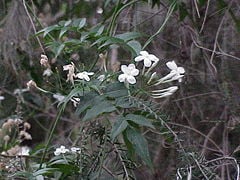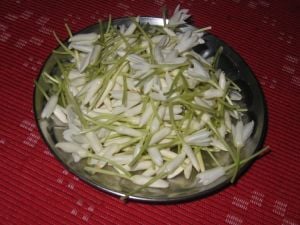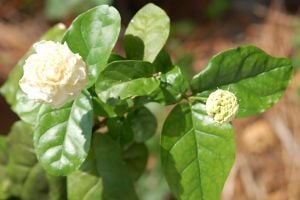Jasmine
| {{{name}}} | ||||||||||||
|---|---|---|---|---|---|---|---|---|---|---|---|---|
 Jasminum polyanthum
| ||||||||||||
| Scientific classification | ||||||||||||
| ||||||||||||
|
See text |
Jasmine or Jessamine (Jasminum) is a genus of shrubs and vines in the olive family (Oleaceae), with about 200 species, native to tropical and warm temperate regions of the Old World. The majority of species grow as climbers on other plants or on structures. The leaves can be either evergreen or deciduous, and are opposite in most species; leaf shape is simple, trifoliate or pinnate with up to nine leaflets.
Jasmine flowers are generally white, although some species have yellow flowers. Unlike most genera in the Oleaceae which have four corolla lobes ("petals"), jasmines often have five or six lobes. They are often strongly and sweetly scented. Flowering is in spring or summer in most species, but in a few species, notably J. nudiflorum, in winter on the bare branches of this deciduous species.
Other plants
Trachelospermum : (Confederate or star jasmine)
Gardenia jasminoides : (Cape jasmine)
Cestrum nocturnum : (Night blooming jasmine)
Gelsemium : (Carolina jasmine)
- Selected species
|
|
Cultivation and uses
Jasmines are widely cultivated for their flowers, enjoyed in the garden, as house plants, and as cut flowers. The flowers are worn by women in their hair in southern and southeast Asia. Some claim that the daily consumption of Jasmine tea is effective in preventing certain cancers. Many species also yield an absolute which is used in the production of perfumes and incense.
Jasmine tisane is consumed in China, where it is called Jasmine flower tea (茉莉花茶; pinyin: mò lì huā chá). Jasminum sambac flowers are also used to make tea, which often has a base of green tea, but sometimes an Oolong base is used. The delicate Jasmine flower opens only at night and is plucked in the morning when the tiny petals are tightly closed. They are then stored in a cool place until night. Between six and eight in the evening, as the temperature cools, the petals begin to open. Flowers and tea are "mated" in machines that control temperature and humidity. It takes four hours or so for the tea to absorb the fragrance and flavour of the Jasmine blossoms, and for the highest grades, this process may be repeated as many as seven times. Because the tea has absorbed moisture from the flowers, it must be refired to prevent spoilage. The spent flowers may or may not be removed from the final product, as the flowers are completely dry and contain no aroma. If present, they simply add visual appeal and are no indication of the quality of the tea.
Jasminum sambac is also the National Flower of Indonesia, where it is known as "Melati", and of the Philippines, where it is known as "Sampaguita". In Indonesia (especially the island of Java), it is the most important flower in wedding ceremonies for ethnic Indonesians. Jasminum officinale is the national flower of Pakistan, where it is known as the "Chameli" or "Yasmine". In Sanskrit it is called Mallika. Jasmine is cultivated at Pangala, in Karnataka, India, and exported to Middle East countries[citation needed].
J. fluminense is an invasive species in Hawaii, where it is sometimes known by the inaccurate name "Brazilian Jasmine". J. dichotomum is also invasive in Florida.
In Thailand, jasmine flowers are used as a symbol of the mother.
Jasmine is the meaning of the name Gelsey. Typically reserved for females, it is of English origin.
ReferencesISBN links support NWE through referral fees
Credits
New World Encyclopedia writers and editors rewrote and completed the Wikipedia article in accordance with New World Encyclopedia standards. This article abides by terms of the Creative Commons CC-by-sa 3.0 License (CC-by-sa), which may be used and disseminated with proper attribution. Credit is due under the terms of this license that can reference both the New World Encyclopedia contributors and the selfless volunteer contributors of the Wikimedia Foundation. To cite this article click here for a list of acceptable citing formats.The history of earlier contributions by wikipedians is accessible to researchers here:
The history of this article since it was imported to New World Encyclopedia:
Note: Some restrictions may apply to use of individual images which are separately licensed.

